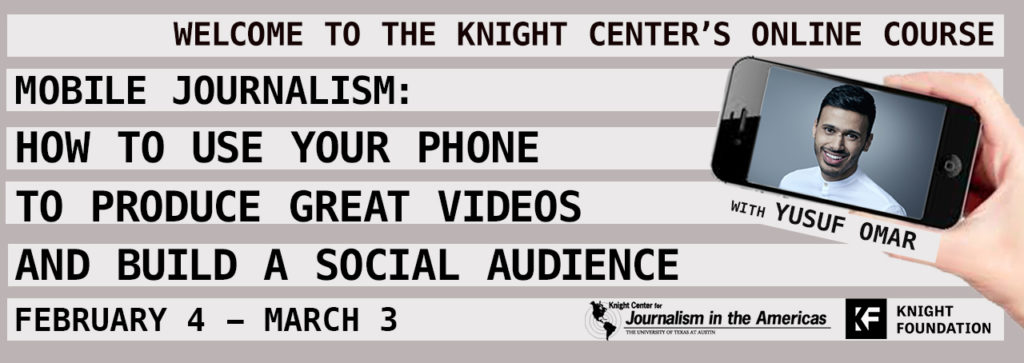
When Yusuf Omar spoke to a crowd of media executives, academics and journalists last April in Austin, he told them “Our future is in our ability to curate and aggregate and listen to the voices of mobile storytellers around the world.”
During the International Symposium on Online Journalism (ISOJ), he provided a window into the 10 years of experience he gained working as a mobile journalist and foreign correspondent. Now, he’s ready to dive deeper and share that knowledge in the next free online course from the Knight Center.
The massive open online course (MOOC), “Mobile Journalism: How to Use Your Phone to Produce Great Videos and Build a Social Audience” runs from Feb. 4 to March 3, 2019. Register now!
The four-week course is offered for free thanks to support from the John S. and James L. Knight Foundation.
Omar, co-founder of Hashtag Our Stories, will teach students how to create social videos with their mobile devices, to be viewed on mobile and social platforms. He’ll teach how to find stories online, capture and edit video with your phone and build strategies for engagement.
“Most of us have a mobile phone in our pocket and it’s like a Ferrari that we’re driving in first gear. During this course, we’ll explore the true potential of mobile storytelling,” Omar said.
Each week of the course will focus on a different topic:
Students will learn how to think mobile-first and tailor their workflows accordingly. They will learn mobile journalism (MOJO) technologies and social video trends. And they’ll learn how to engage with audiences to spread that content far and wide.
By the end of the course, students will have produced a journalistic video for social media.
“The media industry is going through enormous changes and in order to still be relevant, people need to equip themselves with as many different skills as possible,” Omar said. “We need to become Robocop journalists with lots of different tools at our disposal, be it drones and 360 cameras and phones and being able to do live broadcasts.”
“Yusuf Omar electrified the audience at ISOJ last year with practical demos of the use of the cell phones we have in our pockets to improve storytelling in ways we had not imagined. In this course, he now has an opportunity to teach the techniques that can change the ways journalists around the world use their phones to discover and tell stories,” said professor Rosental Alves, founder and director of the Knight Center. “We’re happy to join forces with Yusuf to offer this free online course.”
Students will view video lectures and presentations, complete readings, participate in discussion forums and take quizzes. As with all Knight Center MOOCs, the course is asynchronous, meaning students can finish the activities during the days and times that are most convenient. However, there are recommended guidelines so students don’t fall behind.
“I think the biggest difference between this and other courses is that all of the examples that we do, all of the assignments that we do, are not going to be hypothetical,” Omar said. “They’re going to be real-world situations with real stories, about real people, in real countries, and they’re going to be broadcast to real audiences who are going to give real feedback. So it’s really, really practical.”
Anyone who is interested in video or has a story to tell is encouraged to take the course. Welcoming all editors, designers, filmmakers, wannabe influencers, journalists and copywriters.
Students should have a mobile phone with WiFi, and access to Facebook, Instagram/Snapchat, QUIK and iMovie (iOS) or Power Director (Android).
The MOOC is free, but students who successfully complete course requirements and pay an administrative fee of U.S. $30 will receive a certificate of completion in PDF format. No formal college credit is associated with the certificate.
Sign up for the next Knight Center MOOC and join the ranks of mobile journalists harnessing the power of their phones to tell the world’s stories.
About the John S. and James L. Knight Foundation
The Knight Foundation is a national foundation with strong local roots that invests in journalism, the arts and in the success of cities where brothers John S. and James L. Knight once published newspapers. Its goal is to foster informed and engaged communities, which it believes are essential for a healthy democracy. For more, visit kf.org.
About the Knight Center
The Knight Center for Journalism in the Americas was created in 2002 by Professor Rosental Alves, Knight Chair of Journalism at the Moody College of Communication at the University of Texas, thanks to the generous donations of the John S. and James L. Knight Foundation. The Knight Center’s distance learning program began in 2003 and is funded in part by the Knight Foundation. Over the past six years, the Knight Center MOOCs have reached more than 170,000 people in 200 countries and territories.

Knight Center for Journalism in the Americas
300 West Dean Keeton
Room 3.212
Austin, TX, 78712
Phone: 512-471-1391
Email: journalismcourses@austin.utexas.edu